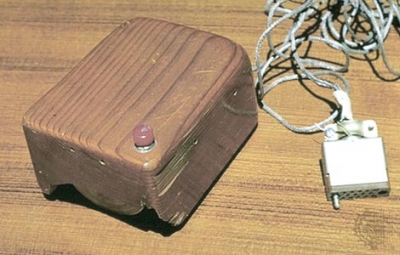
Doug Engelbart invented the computer mouse in 1964. Can you believe that it was made out of wood then, instead of plastic? Rectangular in shape, the wooden mouse had a small button on top right. Engelbart called it a mouse as the cord coming out of its back reminded him of small rodents.
The basic idea for the mouse first came to him in 1961 while sitting in a conference session on computer graphics, his mind mulling over the challenge of making interactive computing more efficient. It occurred to him that, using a pair of small wheels traversing a tabletop, one wheel turning horizontally, one turning vertically, the computer could track their combined rotations and move the cursor on the display accordingly. The wheels could function something like the wheels on a planimeter – a tool used by engineers and geographers to measure areas on a map, blueprint, drawing, etc. – but in this case, rolling the wheels around on the tabletop would plot the x,y coordinates for a cursor on a computer screen. He recorded the idea in his notebook for future reference.
Since 1951 Doug had envisioned intellectual workers sitting at high-performance interactive display workstations, accessing a vast online information space in which to collaborate on important problems. When pondering the question of pointing devices in 1961, he was in the midst of an in-depth study of how teams and organizations might become much more effective in solving important problems. In 1962 he published his findings in “Augmenting Human Intellect: A Conceptual Framework,” which in 1963 garnered him some modest funding from ARPA to begin to hire a very small research team, and set up a basic lab with computer resources, teletypes, and finally, a display workstation.
By now there were several off-the-shelf solutions for moving a cursor and selecting something on a display screen, but no good data about which would be most efficient to meet Engelbart’s “high-performance” requirement. He applied for and was awarded a small grant from Bob Taylor at NASA to explore that question.
Doug and team rounded up then best-of-breed pointing devices to compare, and rigged up some in-house prototypes to add to the mix, such as a foot pedal and a knee-operated device (see Mouse Alternatives below). He also reviewed his earlier notes with his lead engineer Bill English, who built a prototype of the hand-held device with perpendicular wheels mounted in a carved out wooden block, with a button on top, to test with the others. This was the first mouse (pictured above and below). Watch Doug and Bill (above right) discussing this study and the first mouse.
Picture Credit : Google




